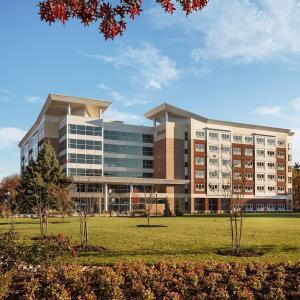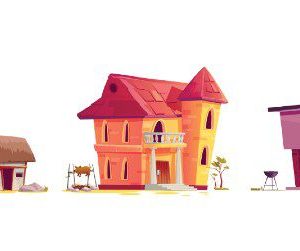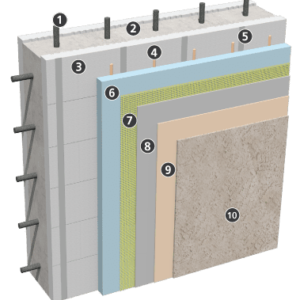Building envelope systems form the primary thermal barrier between the interior and exterior environments and include all the components of a building’s outer shell, the walls, glazings, roof, and foundation. A high-performing building envelope design should prevent air leaks and moisture intrusion through an exterior wall by applying continuous air and moisture barriers to manage water infiltration and accumulation.

Successful application of a high-quality building envelope provides many benefits to a building or home.
- Stops moisture infiltration by preventing condensation in the wall system to resist structurally damaging mildew and mold
Prevents air infiltration through the wall, lessening energy use and costs - Contributes to excellent indoor environmental quality (IEQ) by creating comfortable and mold-free buildings and homes with controlled acoustics
- Manages moisture and air infiltration in a building’s wall system to lower the risk of corrosion and decay, and significantly reduce costly maintenance and repairs
- Controls airborne pollutants, solar radiation, and the spread of smoke and fire
Moreover, the building envelope design should ensure durability, structural strength, pleasing aesthetics, long- and short-term economic feasibility, and code compliance.
The 2021 IECC mandates residential and commercial buildings’ thermal building envelope requirements:
- The 2021 residential International Energy Conservation Code (IECC) Section R402.4 mandates that the building of the thermal building envelope shall limit air leakage according to Sections R402.4.1 through R402.4.5.
- The 2021 commercial IECC Section C402.5 mandates the thermal envelope of buildings shall comply with Sections C402.5.1 to C402.5.8.
Modern Improvements to Building Envelope Construction
The modern approach to achieving a better building envelope system requires builders, architects, and developers to apply the whole-building system. The whole-building system approach requires that the entire construction project team (developers, architects, builders, and designers) work together during the design and building phases towards the overall project goals for a tight building envelope, to ensure energy-efficient, durable, and cost-efficient structures with excellent environmental indoor quality (EIQ).
Today’s building team must consider all components of the building envelope to ensure its performance; however, the exterior walls are its most significant component. High-performing, durable walls of a tight building envelope must include air, vapor, thermal, and water-shedding layers.
Achieving Better Building Envelope Walls with Sto Corp
Sto Corp wall systems provide architects, builders, and developers with cutting-edge building envelope technology to create energy-efficient, durable, safe, and sustainable walls with beautiful and unique aesthetics. Our complete wall systems include all the layers required for a high-performance building envelope system: air, thermal, water-shedding, vapor, water, and durable control layers.
Sto’s Air Control Layer
A high-performance building envelope prevents air transfer (and the moisture contained in it) between the exterior and interior to regulate the indoor climate. An air barrier must stand up to the air pressure differences by minimizing heat losses and gains through conduction, convection, and radiation. In addition, air barriers must prevent air from transporting moisture to the interior of a wall system to stop condensation and the damaging effects of moisture.
Crucial components of a high-quality air barrier include:
- Impermeability to airflow
- The stiffness and strength to withstand forces acting on them during and after construction
- Structural integrity (durability) over the building’s lifetime
- Continuous over the entire building’s envelope
StoGuard® Family of Air and Water-resistive Barriers
Like all Sto wall assemblies, the StoGuard® family of air and water-resistive barrier products provides the first line of protection against air and moisture infiltration, which is a critical feature of a high-performing building envelope.
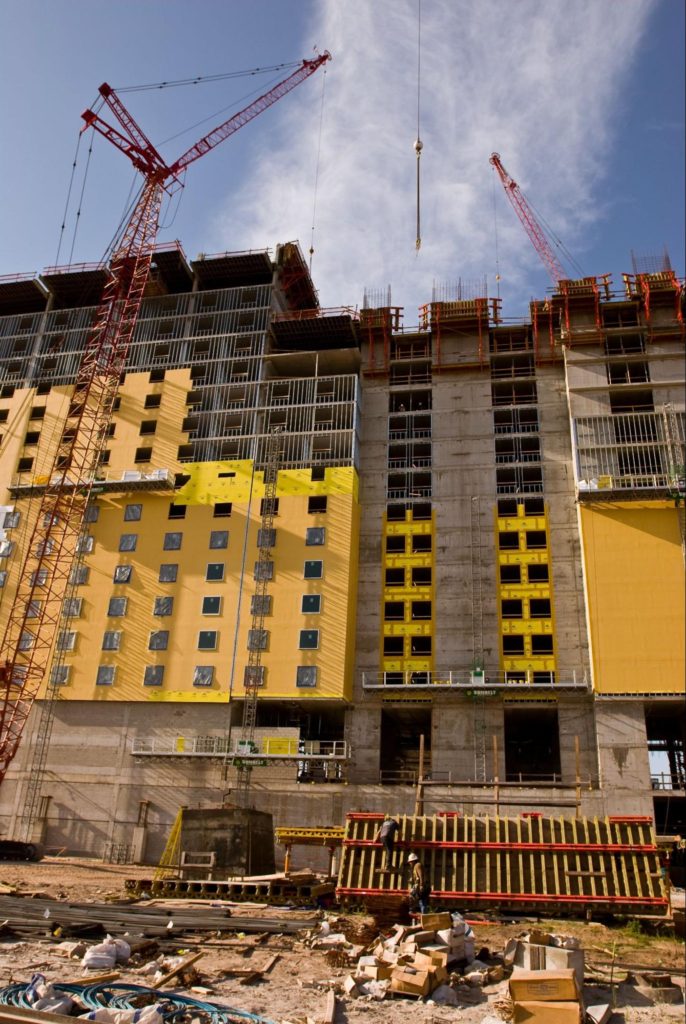
In addition, the StoGuard® System offers seamless control over air and moisture, to improve building performance and occupant comfort. Our air and moisture barrier products include:
- Rough opening protection with a single component, fast-drying multi-use air barrier and waterproof material, a mesh-based product or one component fabric solution. All designed for superior, seamless rough opening protection.
- Fluid-applied air and water-resistive barriers that create a seamless barrier to enhance a building’s energy efficiency and resist moisture infiltration and condensation
- A versatile transition membrane for detailing areas to furnish flexible connections and continuity of the air barrier system
- Sheathing joint treatments featuring a single component, fast-drying multi-use air barrier and waterproof material, one component fabric or mesh-based product solution designed for sheathing protection and seamless joint treatment.
Sto’s Thermal Control Layer
A tight building envelope requires continuous insulation (CI) across all building components without thermal bridges other than service openings and fasteners. Eliminating or minimizing thermal bridging protects the insulation’s R-value. In addition, CI controls thermal heat transfer and reduces condensation and temperature fluctuations.
Sto Rainscreen® Systems Provide Continuous Insulation
StoVentec® Rainscreen® Systems provide a complete solution in a fully-tested, code-approved, back-ventilated system. The easy-to-install glass Rainscreen system furnishes thermally efficient and continuous insulation to limit damaging condensation and lessen the expense of air conditioning and heating.

Its structural frame also enhances safety against wind loads and fire. StoVentec® Rainscreen® Systems can be finished with traditional masonry, plaster, or glass cladding. Our expansive design flexibility offers many textures, colors, shapes, and material type choices to fit the needs of your aesthetic and architectural designs.
Sto Water-Shedding Control Layer
Controlling rainwater infiltration into a building envelope must consider all forces (gravity, capillary action, and wind pressure differences) that drive the water, along with the components required to regulate and combat these forces.
Features that manage water include:
- A well-defined drainage path
- Flashing systems
- A continuous watertight membrane
- Horizontal and vertical plane changes
A cavity wall (drainage or screen wall) provides a concealed open-air space and drainage plane.
Drainable EIFS StoTherm® ci Wall Systems
Drainable EIFS StoTherm® ci Wall Systems integrate drainage, continuous insulation (CI), and a moisture and air barrier to create a durable, long-lasting, and energy-efficient wall system that saves money on repairs, utilities, and maintenance. Additionally, sustainable StoTherm® ci wall systems enhance indoor comfort and air quality. The wall system comes in a wide variety of textured finish options to meet your architectural and aesthetic needs.

Sto Supports Durable Building Envelopes
A building envelope’s long-term performance and durability depend on its resistance to mold, corrosion, decay, and freeze damage. Building envelopes can fail due to poor workmanship, material problems, design flaws, etc. Selecting easy-to-install and durable products, like StoPanel® MVES ci, will help ensure your building envelope’s long-term performance.
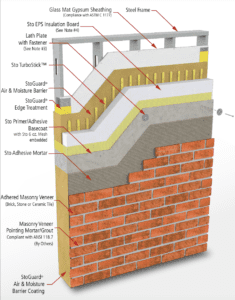
StoPanel® MVES ci combines high strength masonry veneer( natural stone, thin brick, ceramic tile, or cultured stone), a continuous moisture/air barrier, and an engineered insulating wall system. The all-in-one system provides an air and weather-tight wall system with excellent thermal performance and durability.
StoQuik Silver Cement Board Stucco
Fast and straightforward to install StoQuik Silver DrainScreen Systems combine several components into one system to create a moisture-resistant, high-impact exterior wall finish that hastens the delivery time and lessens labor costs compared to traditional stucco:
- Moisture and air barriers to provide moisture protection
- A drainage mat to drain and dry
- Cement board substrate for impact resistance
- Versatile performance and design options of Sto’s numerous textured finishes
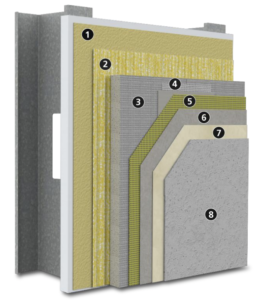
Architectural Coatings
Sto’s advanced architectural vapor permeable low-VOC coatings provide mold- and fade-resistance, self-cleaning properties, and crack bridging. All features provide superior protection against outdoor elements, improve the building’s performance and ensure your structure’s long-term aesthetics. In addition, you can apply Sto’s architectural coatings, which come in many textures, sheens, and colors, either vertically or horizontally.
Hurricane Impact Systems
Sto Hurricane Impact (HI) Systems provide high-impact protection for coastal construction prone to tropical storms, hurricanes winds, wind-borne debris, and water intrusion – events that lead to building envelope failure. Our Sto HI systems meet the strict Miami-Dade County, Florida NOA requirements for wind load resistance, impact resistance, and air and water infiltration.
Vapor Permeable Water-Resistive Barrier
A vapor permeable water-resistive barrier (WRB) under the siding protects walls from rain, vapor, and snow. The WRB must also provide a way for moisture that enters a wall system from a structure’s interior to diffuse through the system and dry. WRBs also often function as a building’s air barrier.
Three basic principles mandate how to manage the flow of water through a building envelope and its removal if it makes it inside the envelope.
- Deflect the water with a correctly installed water-resistive barrier and cladding.
- Install drainage mats that form drainage cavities to drain the water away from the building envelope.
- Provide a WRB with enough permeability so that the system quickly dries.
The optimum perm rating for a WRB prevents water from infiltrating the wall cavity and allows infiltrated moisture vapor to escape.
- Too high a perm will permit moisture from the outside to penetrate the wall system.
- While too low a perm will trap the water within the wall system.
The ideal WRB perm for balancing the inward and outward moisture movement within the building envelope falls between 10 and 20 perms. However, the climate and positioning within the wall assembly also play a role in the WRB permeability.
Sto Corp Systems Offer High-Performance Building Envelope Solutions
Fast and simple to install, Sto Systems provide architects, contractors, and developers with a tested and cutting-edge high-performance building envelope. Sto’s single product wall systems deliver on all performance needs, saving money and time and lessening labor, risk, and complexity compared to systems that need piecing together of many components from multiple sources.
Independent testing shows that Sto systems meet water infiltration and ventilation performance specifications, wind load resistance, impact resistance, water resistance, flame spread, and accelerated weathering.
For more on achieving better high-performance building envelope systems, download our comprehensive guide on engineered building enclosures or contact us today.
